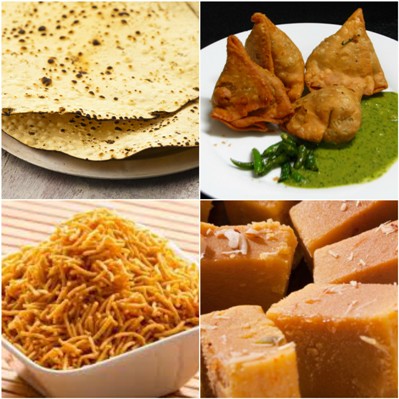

By Meenu Agarwal
First publised on 2020-05-08 09:39:58
Junk food is defined as "any food, which is low in essential nutrients and high in everything else - calories and sodium". Junk foods contain little or no proteins, vitamins or minerals but are rich in salt, sugar, fats and are high in energy (calories). Junk food is popular because it is tasty, but it is unhealthy. It is low in fiber, high in fat, and sugar in liquid form. Studies have shown that despite being unhealthy, junk food induces gorging that leads to obesity. Below, we focus on 4 unhealthy though popular snacks.
Papad
Both North and South Indian lunches and dinners are incomplete without the all-time favourite Papads. Rice, dal, sabji, aachar along with papad is a must in our homes. And, if papad not there, it can be a cause for much displeasure.
The recipe for making papad is handed down over generations. Rice, flour, lentils, potatoes, chickpeas or black gram and various spices, salt and peanut oil are ground together to prepare a smooth dough. This dough is then spread in round flat thin bread and sun-dried. Some of us have seen our grandmoms and moms spending afternoons making papads. In some places, it is a family event with all the aunts coming over to make them.
Papads are served either fried or roasted. They are okay for occasional consumption, but not for excessive or even regular indulgence. Papad has a large amount of salt which acts as a preservative and also makes the papad tasty. However, too much salt (sodium) in our body leads to high blood pressure, water retention, abdominal bloating, increased thirst, diabetes, etc. Some of our papad varieties have liberal servings of spices. The excess of spices is also not good.
We typically consume at least 2-3 pieces of papad in one sitting and immediately feel acidic with unpleasant burps and sensation of indigestion. When consumed in excess, papads may stick to the intestinal lining and can lead to constipation and gastric issues.
Fried Papad v/s Roasted Papad?
Fried papads cooked in the same oil repeatedly which is rich in trans fats. Transfat is extremely dangerous and will lead to an increase in levels of bad cholesterol in the body causing heart problems, diabetes etc. While roasted papads are better than fried papads, daily roasted papad intake is not recommended, as it is very acidic and has high sodium content.
I am not trying to scare you all but if you care about your body then be considerate and controlled in your consumption of papads.
Samosa
A medium to large size samosa gives us 250 - 310 calories and is loaded with carbs and fats. The cooking oil in which it is cooked is the main culprit. Roadside stalls use the same oil to fry multiple times making the oil stale. Most of the time, hydrogenated oils (contain transfats) are used to fry samosas. Transfats are generated when liquid oils are turned into solid or semi-solid fats through hydrogenation, a process by which hydrogen is added to vegetable oil. This happens when oil is recycled during cooking, or when food is heated over and over again in the same oil it was cooked in. Hydrogenation increases shelf life and improves taste making samosas tastier and crispier. Samosas are very fattening. Cholesterol, digestion issues, trans fats, refined flour are good reasons to think before you snack on samosas.
Home made samosas or Frozen samosas?
Homemade samosas are relatively better than street samosas if we don't re-use oil and if we use healthier fillings as compared to street fillings.
Frozen samosas are pre-fried and again needed to be fried at home, so not much better.
Snack on something healthier, other than samosas. Burning 300 calories will require you to walk an average of approx. 6 km. Samosa or Health - the choice is yours.
Bhujia
Bhujia is one of the most popular junk food that we consume. Almost every Indian household has 1-2 packets of bhujia (can be any variant) in their monthly grocery list and bhujias occupy permanent space on the dining table. For every holiday travel, a variety of bhujias is a must pack. But how many times do we really look at the nutritional content of each serving of the bhujia. One serving is typical 10 grams and the minimum intake in one sitting is 3-8 spoons (30 gms to 80 grams). The nutritional content of 100 gms of Aloo Bhujia is Energy - 630 kcal, Protein - 5 g, Total Carbohydrate - 40 g, Total Fat - 50 g, 6Trans Fats - 0 g. Cholesterol - 0 mg, Sodium - 670 mg. Calorie break down 71 % fat, 25 % Carbohydrate and 3 % Protein. Most of the bhujias are deep fried and also use preservatives to increase the shelf ilfe. Consuming bhujias for long periods can lead to high blood pressure, high cholesterol and diabetes.
Mysore Pak
Flying out of Chennai on some occasions, I have seen lots of fresh packs of Mysore Pak being bought from Krishna Sweets. Growing up in Calcutta (now Kolkata), the sweet was new for me. We grew up only on the traditional chhenar rosogollas and sandesh. Having tasted the Mysore Pak, I found it to be a delicious sweet which melts into the mouth. Aha..! Mysore Pak is one of the most popular sweets in South India and is prepared using large amounts of ghee, vegetable oil, sugar, water and besan (gram flour). On average the serving size of 50g gives around 200 calories with about 100 calories coming from fat. The sweet provides generous amounts of saturated fat and sugar. From a health point of view, regular consumption is not recommended with occasional treat advisable for the sweet cravings.
Before, you pop 2-3 pieces, imagine the amount of work you would need to do to burn those extra calories.
What are some healthy snack options that you can have:-
1. Murmura or puffed rice (muri from Bengal).
2. Nuts like almonds and peanuts.
3. Tal makhana (lotus seeds or fox nuts) - roasted and unsweetened.
4. Sprouts salads.
5. Fresh cut vegetables with hummus or guacamole.
6. Fresh cut fruits.
7. Poha
So next time THINK before you polish the papads, samosas, bhujias and mysore paks in the evenings, when you are hungry or with your liquor. Put a limit on the frequency and the quantity. Your health is in your hands.











